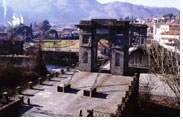
The World Monuments Fund (WMF) and American Express Company on June 15 announced grants totaling $1 million, made available by American Express through WMF's World Monuments Watch program. The grants will aid 12 historic sites that are on WMF's 2000 Watch List of 100 Most Endangered Sites.
American Express's 10-year, $10 million commitment to the World Monuments Fund to preserve endangered sites has enabled WMF to leverage millions more from local and national governments, global corporations, foundations, and individuals and has encouraged new activism worldwide. Launched by WMF in 1995, the World Monuments Watch program and its List of 100 Most Endangered Sites sets priorities and raises funding for imperiled historic, artistic, and architectural sites worldwide.
The private, nonprofit World Monuments Fund, an international organization with headquarters in New York City, has been preserving and safeguarding the historic, artistic, and architectural heritage of humankind for more than 35 years. Every other year, the World Monuments Fund invites governments and nongovernmental organizations around the world to nominate endangered sites for inclusion on the List of 100 Most Endangered Sites. (The 2002 List will be announced in October this year.) Each year, grant recipients are selected from the current list. Since the program's inception in 1995, 226 grants to 128 sites in 60 countries have been awarded for a total of $12.6 million. At least $39 million more has been leveraged through donations from governments, businesses, individuals, and institutions directly to the sites for restoration.
 Chile,
Easter Island, Orongo Archaeological Site (15th–18th century),
for petroglyph monitoring and site interpretation
Chile,
Easter Island, Orongo Archaeological Site (15th–18th century),
for petroglyph monitoring and site interpretation
China, Beijing, Temple of Agriculture (15th century), for conservation of the Banqueting Hall
Dominican Republic, Puerto Plata, Puerto Plata Lighthouse (1879), for conservation of one of the few cast-iron lighthouses still standing in the Americas
Egypt, Luxor, Thebes, Valley of the Kings (16th-11th century BCE), for conservation project in the Tomb of Tausert/Setnakht, where nearly all of Egypt's New Kingdom pharaohs, including Tutankhamen, Seti I, and Rameses II, are buried in the Valley of the Kings
 Italy,
Bagni di Lucca, Bridge of Chains (1839-1860), to initiate conservation
work on this glorious suspension bridge featuring a wooden platform, triumphal
arched gateways faced in sandstone, and delicate yet vigorously articulated
iron members; the surface of the bridge is worn, the nodes of the chains
appear compromised, and sandstone surfacing is flaking
Italy,
Bagni di Lucca, Bridge of Chains (1839-1860), to initiate conservation
work on this glorious suspension bridge featuring a wooden platform, triumphal
arched gateways faced in sandstone, and delicate yet vigorously articulated
iron members; the surface of the bridge is worn, the nodes of the chains
appear compromised, and sandstone surfacing is flaking
Mexico, Veracruz, San Juan de Ulua Fort (1535-1786), for stabilization and conservation of the Nuestra Señora del Pilar Lunette
Pakistan, Balawalpur, Punjab, Uch Monument Complex (ca. 2nd millennium BCE–AD mid-16th century), for continued planning and implementation of conservation work
Slovakia, Krajné Cierno, Basil the Great Church (1750), for stabilization and conservation work of a magnificent wood church
Turkey, Kâhta, Mount Nemrut Archaeological Site (80 BCE-72 BCE), for on-site conservation laboratory, training, and stone materials research for the stone funerary site of King Antinochus I
Turkmenistan, Bairam Ali, Merv Archaeological Site (6th century BCE-AD 15th century), for emergency stabilization and conservation of a series of mud-brick cities built side-by-side over a span of 2,000 years
 USA,
Pennsylvania, Lancaster County (AD 18th-19th century), for a feasibility
study on restoring historically significant buildings in downtown Lancaster—haven
for the Amish, Mennonite, and other Anabaptist faith communities—that
have been badly eroded and degraded by suburban sprawl
USA,
Pennsylvania, Lancaster County (AD 18th-19th century), for a feasibility
study on restoring historically significant buildings in downtown Lancaster—haven
for the Amish, Mennonite, and other Anabaptist faith communities—that
have been badly eroded and degraded by suburban sprawl
Vietnam, Duy Xuyen, Quang Nam, My Son Temple District (AD 300–1200), to control water damage and for conservation of sculptures and tower-temples in My Son, the royal seat of the Champa Kingdom.
Copyright 2001 The American Institute of Architects. All rights reserved.
![]()
|
For the complete List of 100 Most Endangered Sites and additional information (including how to nominate a site for the list), visit www.wmf.org. If you would like to contact the WMF by mail, please note its new address: World Monuments Fund phone, 646-424-9594 |
|